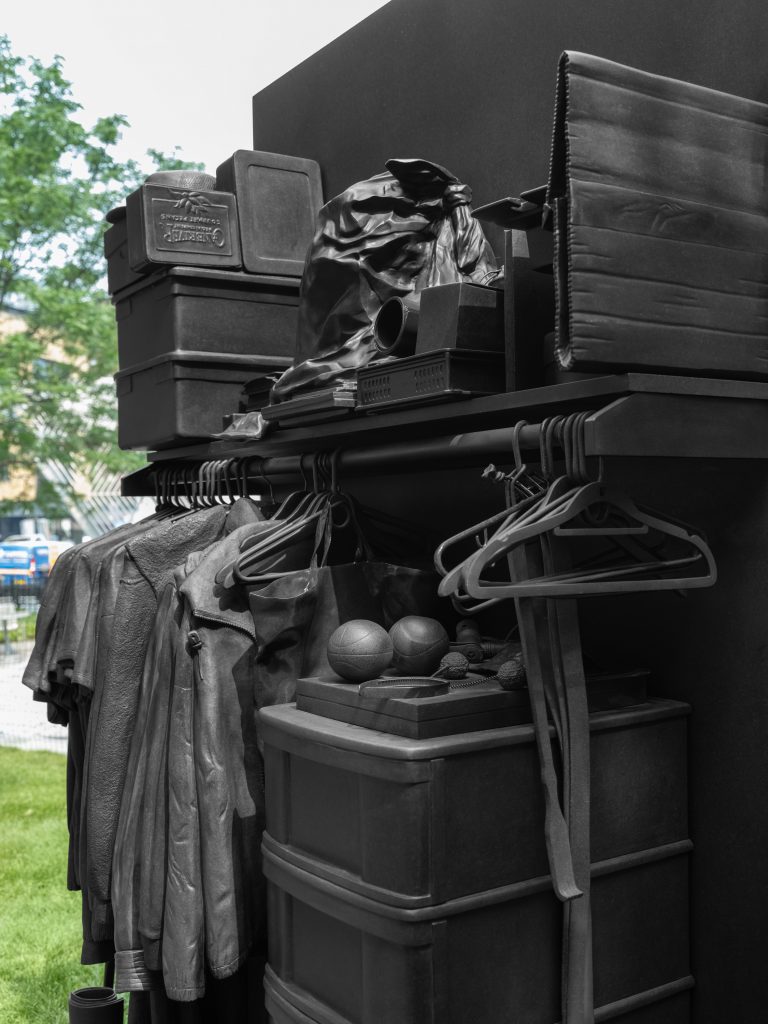An open closet now sits in New York’s AIDS Memorial Park. There are hangers and hoodies, stacked boxes and folded weekend bags. The structure resembles, in other words, a generic storage space. It is and it is not.
The piece, called Craig’s Closet (2023), was created by artist Jim Hodges in memory of the more than 100,000 New Yorkers who have died as part of the HIV/AIDS epidemic – of whom he has called more than a few friends and colleagues. It is built to scale in granite and bronze and painted in a mysterious and funereal black.
You don’t need to know the name of Hodges’ sculpture to figure out that it was based on a specific person. The specificity of the work, down to the folds of the shirts, reveals that the piece was an act of recreation rather than strict imagination. But despite the attention to detail, we still don’t know who Craig is. We don’t know their surname or relationship to the artist; we don’t know if they died or how.
Hodges, for his part, is not interested in sharing this information. He does not want speculation about his relationship to the subject to distract from the universal valence of the work.
“The staff is evident in the work itself,” he said in an interview. “I think developing this narrative takes away the focus from the object and I would prefer not to.”
This is one of the many tensions at the heart of the work. Craig’s Closet is intimate but anonymous. Its material is hard but its subject is soft. Like most public pieces, it is strong and heavy, built to withstand weather and crowds; but what it symbolizes is the opposite: the fragility of life.

Jim Hodges, Craig’s Closet (2023), detail. © Jim Hodges. Courtesy of the artist and Gladstone Gallery. Photo: Daniel Greer.
Hodges, who lives and works in New York, moved to the city as a fledgling artist in the mid-1980s, at the height of the HIV/AIDS epidemic. He absolutely knew many of those affected by the crisis, including his close friend Felix Gonzalez-Torres, who died of an AIDS-related illness in 1996.
But when asked about these experiences, Hodges went into hiding again, insisting that his sculpture points outward rather than inward.
Rather, he drew attention to the history of the site on which his works are located. Nearby is St. Vincent’s Hospital, a facility once called ground zero for the AIDS epidemic, as well as the haunts of the Greenwich Village neighborhood, home to generations of artists, activists and performers .
Hodges said the purpose of the piece was “to use this space, its proximity and its context as a sort of portal of expansion for people to enter from their own points of reference”. Fittingly, the bare back of the sculpture is reflective: “Being able to glimpse yourself in the work is important to me,” he added.
That Hodges moved into the closet, an already loaded metaphor, as his memorial speaks volumes about his intentions. The sculpture subverts the site as a space in which identities are concealed. Instead, it presents the closet as a sort of stage on which we place all the little tokens in our lives.
“The stage is set and the stories bloom every time the doors open,” the artist wrote in a description of his work. “This openness gives us a reminder, an understanding of who we are, where we’ve been, of the secrets and dreams we carry.”

Jim Hodges, Craig’s Closet (2023), detail. © Jim Hodges. Courtesy of the artist and Gladstone Gallery. Photo: Daniel Greer.
The care with which Hodges crafted the sculpture shows how personal it is to him, even if he refuses to talk about it. “It takes a tremendous amount of love to do work that you want people to feel,” he said. “It’s the norm: to love it.”
Craig’s Closet (2023) runs through May 2024 at New York City AIDS Memorial Park.
Follow Artnet News on Facebook:
Want to stay one step ahead of the art world? Subscribe to our newsletter to receive breaking news, revealing interviews and incisive reviews that move the conversation forward.
